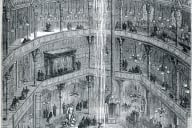You have /5 articles left.
Sign up for a free account or log in.
In June, Inside Higher Ed told readers about Princeton University Press’s impending experiment with a political-science volume on the 2012 presidential election: It would make excerpts from the work-in-progress available online free while the campaign was still under way. It required a “truncated timetable” for peer review -- getting the readers’ reports back in two or three weeks instead of a few months.
Given the stately pace of scholarly publishing, such a turnaround counts as feverish. By the standards of punditry, it’s almost languorous. The idea was to give the public access to portions of The Gamble: Choice and Chance in the 2012 Election just as the convention season began.
And so they are. Two chapters are now available for download from the Princeton website, here and here. The authors, John Sides and Lynn Vavreck, also have a website for the book. (They are associate professors of political science at George Washington University and the University of California at Los Angeles, respectively.) The material runs to about a hundred pages of text.
It would be hard to read Sides's and Vavreck’s work during the conventions, amid all the funny hats and confetti. But their research puts a couple of things about the campaigns into perspective. Keep in mind that the authors are responding not just to data (most of it quantitative) but to the received wisdom of the past several months regarding the campaign -- and on two points in particular.
Each is an assessment of a candidate’s presumed vulnerabilities.
The first holds that President Obama’s chances of re-election depend -- more than anything else, and perhaps even exclusively -- on the state of the economy. Incumbency has its advantages, but unemployment rates could trump them. The second is that Mitt Romney lacks the support of his party’s base, which is considerably to the right of him on both social and economic issues. Romney doesn’t suffer from Sarah Palin’s very negative approval rating among the public at large, but he can’t count on the support of her followers, Twitter and otherwise.
In social-science books, the methodology is usually as salient as the findings themselves. Each chapter comes with an appendix stuffed with additional analysis. Suffice it to say that a few patterns have emerged from studies of presidential campaigns in the past. The challenge is to move from generalizations about yesteryear to the electoral battle now unfolding.
For example, the country’s economic performance during a president’s administration -- but especially in the months just before the election -- is a pretty solid index of his re-electability. In the sixteen presidential elections between 1948 and 2008, changes in gross domestic product between January and September of the election year tracked closely to the fortunes of the incumbent party’s candidate. “It’s hard to beat an incumbent party in a growing economy,” Sides and Vavreck write, “and even harder to beat the actual incumbent himself.”
When the change in GDP over the three quarters preceding the election is negative, the incumbent party’s presidential candidate is sure to lose -- at least if the examples of Nixon (1960), Carter (1980), and McCain (2008) are anything to go by. The stronger the economic contraction, the bigger the defeat.
But the pattern of the past 60 years isn’t much help for handicappers of the race now under way. GDP during the first quarter of 2012 grew an incumbent-friendly 2 percent, while the initial estimate for the second quarter was 1.5 percent growth. As it happens, this column is running on August 29, when the Bureau of Economic Analysis is scheduled to issue a revised estimate of second-quarter growth based on additional data. (And the first estimate of GDP in third quarter isn’t out until 12 days before the election.)
In any case, the GDP itself can give only a rough sense of how voters experience and understand the economy. Sides and Vavreck have developed a model that correlates public-opinion poll results from each quarter between 1948 and 2008 with a number of other data points. These include three economic factors (unemployment and inflation rates, plus the change in GDP between quarters) as well as “events such as scandals and wars that might push approval [ratings] up and down” and the president’s length of time in office, counted in quarters.
From all of this information, the authors extracted a general model of how much each factor counted in determining the presidential approval ratings. Then they ran all the numbers again to see how well the general model could retroactively “predict” the changes in each president’s approval ratings from quarter to quarter. And the model proved good at it. The actual quarterly ratings were usually quite close to what the formulas expected, given the economic and other factors in play.
Plugging in relevant data for 2009-2011, the authors generated a graph showing the approval ratings that would be expected given the tendencies of the previous six decades. Here things get interesting:
“Although early on in his presidency Obama was slightly less popular than expected (by about 1 percent throughout most of 2009 and 2010), by the end of 2010 and continuing into 2012, he was more popular. In 2011, his popularity exceeded expectations by over 6 points. This feat is something that few presidents have accomplished. Only one president, Ronald Reagan, consistently ‘beat’ the prediction in his first term to an extent greater than Obama.”
The authors suggest that, if anything, their model may have overestimated the level of Obama popularity that might be expected if all things were equal, relative to earlier presidencies -- which they weren’t. The economic slump that began in 2008 has been deeper, and lasted longer, than any over the previous 60 years. High unemployment yields diminished approval ratings, of course -- but compounding it with a rise in long-term unemployment should presumably push them down even harder.
At the same time, the model does not account for what the authors call “the ‘penalty’ of his race” -- the marked tendency of those with negative attitudes toward black people in general to disapprove of Obama in particular. Sides and Vavreck estimate that his approval rating might be up to four points higher if not for his skin color.
In short, Obama entered the 2012 campaign with considerably more support than one might expect given the lackluster economy. The authors leave it to others to speculate on the source of this strength. But what about his opponent? Isn't Mitt Romney out of step with the rest of his party -- hence vulnerable to conservatives staying home?
When he emerged from the Republican primary season a few months back, Romney seemed less a victor than the last man standing. And inexplicably so: until a few years back, he spoke in favor of both Roe v. Wade and LGBT equality. And Jonathan Gruber, the economist at the Massachusetts Institute of Technology and "intellectual architect" of the healthcare reform bill that Romney crafted while governor of Massachusetts, has compared it to Obamacare in colorful terms: “it’s the same [flippin’] bill.” Shouldn’t he be exhibited by the Smithsonian Institution as the last surviving member of an extinct species, the Rockefeller Republican?
Sides and Vavreck challenge the idea that the Republican primary process revealed a deep yearning by conservatives for “Anyone But Romney.” All the other candidates courted them assiduously, only to be done in by scandal or gaffe or the inability to remember which government programs he or she intended to close down, once in office. Romney was what the party had left. (Actually "had left" is probably a bad way of putting it.)
The authors concede that Romney “never ‘surged’ in the polls" in late 2011 and early ’12, "and never experienced the reinforcing cycle of positive news coverage and gains in the polls.” As a result, he "appear[ed] to be a weak candidate, unloved by many in the party. But this also concealed the underlying structure of the race, which tilted in his favor.” A poll from last December showed that he “was viewed positively by likely Republican primary voters whether they were conservatives or moderates, pro-life or pro-choice, relatively wealthy or not.” More than two-thirds of the Tea Party members surveyed expressed a favorable opinion of him, with non-Tea Party people doing so at the same rate.
The authors make their case with charts, graphs, and whatnot, but looking at them, I felt some cognitive dissonance. It’s hard to shake the impression that the GOP has a sizable wing that is so far to the right of Romney that he had to placate them with a veep candidate with stronger conservative credentials. When I raised the issue to the authors by e-mail, Sides replied that "people have overestimated two things about GOP voters: (1) just how conservative they are (or perceive themselves), relative to how they perceived Romney; and (2) how much ideology drove their feelings about Romney and the other candidates.” That misperception was strengthened by the “media boomlets” that seem intrinsic to the 24-hour news cycle.
“When news coverage focused on a candidate other than Romney and that candidate had conservative bona fides,” Sides continued, “then conservatives were more likely to vote for that person than Romney…. But this does not mean they were implacably opposed to Romney. Preferring another candidate to Romney is not the same as opposing Romney.” He may have won out “not because he was ideologically who every conservative activist or voter wanted, but because he was the compromise candidate of the various party's factions. It doesn't mean he was widely loved, but he was satisfactory to all. Which makes him like most other presidential candidates, really.”
The authors are still analyzing the primary season while also following the latest twists and turns of the process. I wondered if that meant the chapters now available were working drafts of a sort.
“We will probably rework the chapters a little bit,” Lynn Vavreck wrote back, “but not very much I suspect. We may adjust some of the error or uncertainty estimates, but the general take-aways will remain the same.”
Writing a monograph with the campaign still in motion is a way to shake things up some in the discipline. “It bothered us that parties, candidates, consultants, and journalists had better data on campaigns and elections than political scientists had -- and we wanted to be a part of what was happening, when it was happening, so we could share in those data and use them in real time.”
They hope the project serves as a model to others, while acknowledging that it’s “not the kind [of effort] that academics are typically strong on making -- partnerships have to be forged, things have to be delivered on deadline, and you have to promote your results and your work to a wider audience.” It sounds like what anyone else engaged in politics must do, except with a bibliography.




